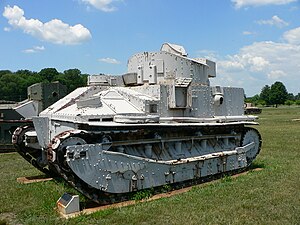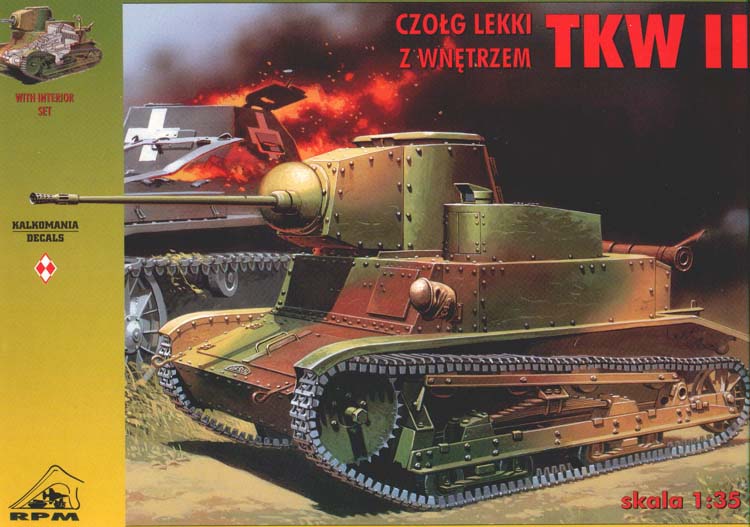Ryhmän mimeksi annettiin Experimental Mechanized Force (mekaanisoitu kokeellinen
joukko-osasto). Myöhemmin osaston nimi valittiin panssarijoukot (Armored Force).
Osasto sai paljon mielenkiintoa myös monessa muussa maassa. Kuitenkin tämän hyvin lupaavan ja hyvin alkaneen kokeilun jälkeen panssari-voimien kehitys lopettiin.

Samalla tavalla kuin jälkeen WW-I, kun Englanti supisti kaikki asevoimat minimiin.
Yleinen ase-velvolliuus päättyi, vain siirtomaiden hallinnan yllä pitämiseen tarvittava asevoima jätettiin vara-voimaksi.
Sen sijaan laivasto kehitettiin huippuunsa ja pian Englanti oli voimakkain meri-mahti.
Tähän johti tankkien kehitys halu, joka kaatui muiden sotilas tahojen vastustamiseen, jotka pitivät panssarivaunua edelleen vain jälkaväen hyökkäystä tukevana aseena.
Tämä johti englannin panssarivaunu kehityksen lähes täydelliseen pysähtymiseen
vaikka Fuller ja Liddel-Hart pyrkivät kehittäämään tankkien käyttämisen periaatetta,
kykyä itsenäiseen toimintaan, hyökkäykseen ja taisteluun vihollisen vaunuja vastaan.
Mikäli myös muut aselajit motorisoidaan voidaan sodan käynti täydellisesti uudistaa.
--------------------------------------------------------------------------------------------------------------------

The Experimental Mechanized Force was a brigade-sized formation of the British Army. It was officially formed on 27 August 1927, and was intended to investigate and develop the techniques and equipment required for armoured warfare.
As such it was the first armoured formation in the world.
It was renamed the Experimental Armoured Force the following year. Over a period of two years, it participated in several exercises which proved the capabilities of mechanised forces against traditionally-organised and trained infantry and cavalry but also generated violent arguments within the Army.
The Force was finally dispersed in February 1929. It was followed by experiments in a "Mixed Tank Brigade"
In the aftermath of World War I, several theorists sought ways to avoid the indecisive nature of trench warfare, with its associated heavy casualties. One weapon which had shown promise was the tank.
Colonel J. F. C. Fuller, formerly the Chief of Staff of the Tank Corps, proposed an all-tank force, which would operate independently against enemy headquarters and lines of communication. More moderate theorists such as the historian and former British Army officer Basil Liddell Hart advocated mechanised forces of all arms, able to carry out operations of war other than the all-out offensive.
A third influential reformer, Colonel Giffard LeQuesne Martel proposed that tanks should nevertheless be subordinated to infantry formations, while the large number of influential cavalry officers maintained that the horse still had a part to play on a modern battlefield, in spite of all evidence to the contrary on the Western Front in World War I.
Following pressure from Fuller and from George Lindsay, the Inspector of the Royal Tank Corps, General George Milne, the Chief of the Imperial General Staff, arranged for the formation of the Experimental Mechanized Force in October 1925.
Milne was already inclined against the pure tank theorists, and organised the force as a balanced force of all arms, so far as resources allowed.
After the units concerned had completed their training on their new equipment, the Force officially came into existence at Tidworth on Salisbury Plain in August 1927.
Colonel Fuller had originally been considered for appointment as commander of the Force but he turned it down, as it was combined with command of an infantry brigade and the administrative responsibilities connected with the garrison of Tidworth.
The War Office refused to allot extra staff to assist him, and Fuller believed he would be unable to devote himself to the Force and its methods and tactics.
Instead, Colonel R. J. Collins, whose professional background was light infantry and was the commander of the 7th Infantry Brigade, was appointed to command the Experimental Force.

Over the two years following its formation, the Force participated in several exercises on Salisbury Plain, the traditional training area of the British Army, which was generally open with firm going and therefore ideal for mechanised units. Mikäli myös muut aselajit motorisoidaan voidaan sodan käynti täydellisesti uudistaa.
--------------------------------------------------------------------------------------------------------------------

The Experimental Mechanized Force was a brigade-sized formation of the British Army. It was officially formed on 27 August 1927, and was intended to investigate and develop the techniques and equipment required for armoured warfare.
As such it was the first armoured formation in the world.
It was renamed the Experimental Armoured Force the following year. Over a period of two years, it participated in several exercises which proved the capabilities of mechanised forces against traditionally-organised and trained infantry and cavalry but also generated violent arguments within the Army.
The Force was finally dispersed in February 1929. It was followed by experiments in a "Mixed Tank Brigade"
In the aftermath of World War I, several theorists sought ways to avoid the indecisive nature of trench warfare, with its associated heavy casualties. One weapon which had shown promise was the tank.
Colonel J. F. C. Fuller, formerly the Chief of Staff of the Tank Corps, proposed an all-tank force, which would operate independently against enemy headquarters and lines of communication. More moderate theorists such as the historian and former British Army officer Basil Liddell Hart advocated mechanised forces of all arms, able to carry out operations of war other than the all-out offensive.
A third influential reformer, Colonel Giffard LeQuesne Martel proposed that tanks should nevertheless be subordinated to infantry formations, while the large number of influential cavalry officers maintained that the horse still had a part to play on a modern battlefield, in spite of all evidence to the contrary on the Western Front in World War I.
Following pressure from Fuller and from George Lindsay, the Inspector of the Royal Tank Corps, General George Milne, the Chief of the Imperial General Staff, arranged for the formation of the Experimental Mechanized Force in October 1925.
Milne was already inclined against the pure tank theorists, and organised the force as a balanced force of all arms, so far as resources allowed.
After the units concerned had completed their training on their new equipment, the Force officially came into existence at Tidworth on Salisbury Plain in August 1927.
Colonel Fuller had originally been considered for appointment as commander of the Force but he turned it down, as it was combined with command of an infantry brigade and the administrative responsibilities connected with the garrison of Tidworth.
The War Office refused to allot extra staff to assist him, and Fuller believed he would be unable to devote himself to the Force and its methods and tactics.
Instead, Colonel R. J. Collins, whose professional background was light infantry and was the commander of the 7th Infantry Brigade, was appointed to command the Experimental Force.
The Force's operations were almost invariably judged to be successful by the umpires. Its all-arms composition generally vindicated Liddell Hart's concepts, as the Force was able to undertake operations such as opposed river crossings which would have been impossible for an all-tank force.
Nevertheless, Liddell Hart complained that the Force's operations were too small in scope and always served as an adjunct to larger, traditionally organised forces, rather than demonstrating that mechanised forces could operate independently and be strategically decisive.
Another shortcoming which the exercises highlighted was that the infantry's lorries could not keep up with the tanks on rough going.
The solution, which would be to provide the infantry with tracked or half-tracked armoured personnel carriers, was too expensive. After the Experimental Armoured Force was disbanded, the British Army formed ad hoc armoured forces in which the Tank brigades and Motorized Infantry brigades tended to operate independently of each other, a fault repeated in the early years of World War II.
----------------------------------------------------------------------------------------------------------------------
Muutama yksityinen valmistaja kuitenkin kehitti vaunuja edelleen. Koska kysyntää ja kiinnostusta ei valtion taholta ollut, nämä panssarivaunut jäivät usein vain protyypiksi tai muutamaan koemalliin.
Englanti osti muutamia pieniä konekiväärillä aseistepanssarivaunuja eri valmistajilta.
Vickers Mark IV

Renault Tankette

Garden-Lloyd Mark-VI oli eräs, ja samalla sellainen jota myytiin myös 12 eri maahan,
Puola valmisti monta eri versiota, Ranska Renault U-I, Italia CV-29 ja 3, 33 ja 35 mallit,
Tsekkoslovakia Skoda MU 4. Brittiarmeijalle vaunuja valmstettiin satoja 1930-1940.
Ranskassa 1940 olevien brittiläisten joukkojen käytössä Mark VI-B vaunuja 210 kpl.
Vaunun 4 sylinterinen bensiini moottori oli suojaamaton ja se oli asennettu miehistön väliin, joten etenkin kesällä vaunussa oli liian kuuma.
1930 näitä vaunuja osti myös Neuvostoliitto, yhteensä 26 kpl, sekä lisenssi oikeuden ja valmisti siitä oman mallin joka sai tyyppinimen T-27. Vaunu pystyi uimaan.
Vaunuja valmistettiin vuodesta 1931 - 1939 asti ja valmistusmäärä noin 4000 kpl.

Vickers Medium Mark-II
Vickers-Armstrong valmisti kaksi (1x Mark-I + 1x Mark-II) panssarivaunua, vuosi 1926.
Paino:13,50 tn (long ton)
Pituus: 5,33 cm
Leveys: 2,78 cm
Korkeus: 3,01 cm
Tykki 47 mm
Konekivääri 6 kpl
Miehistö 5 kpl
Moottori: Ilmajäähdytteinen Armstrong-Siddeley V-8 otto moottori, 90hp/66kw.
Vaihteisto: 4 nopeutta
Nopeus: 26 km/h,
Toiminta-matka: 190 km
Panssari: 8 mm
Viestiväline: Radio
Ohjaus: Kytkin - Jarru menetelmä
Nämä olivat WW-I jälkeen ensimmäiset englannissa valmistuneet panssarivaunut.
Vaunuja käytettiin koulutukseen vielä 1941.
Vuosien 1923 - 1929 aikana englannissa valmistui vain 160 kpl Medium Mk-II tankkia.
Tämä malli oli varustettu pyörivällä tornilla, ja ensimmäinen valmistettu "torni"-malli.
vaikka tornia oli jo kokeiltu Mark IB mallissa, johon asennettu tykki oli ollut liian suuri.

Mark-II mallista valmistui parannettu Mark-II A malli 1930. Mallia valmisttettiin 20 kpl.
Vanhempiin Medium Mark-I Ja Medium Mark-II vaunuihin ero ei ollut suuri.
Moottori edessä ajajan oikealla puolella, voiman siirtolaitteet keskellä, ohjaus takana.
Taistelutilan lattia kiinteä.
Torni jossa neljä (4) konekivääriä, yksi tykin vieressä, kaksi sivulla ja yksi katolla.
Lisäksi molemmalla sivulla oli yksi konekivääri.
Kaikissa panssarivaunussa oli radio.
Mukavutta tuomassa oli keitin, sekä kolmen päivän ruoka tankin miehistön jäsenille.
Neuvostoliitto osti 1930 näitä Mark-II A mallin vaunuja 15 kpl.
Vaunuille annettiin Neuvostoliitossa nimi Englantilainen työläinen.
Vaunujen lisensioikeutta neuvostoliitto ei käyttänyt, joten valmistusta ei aloitettu.
Paino:13,50 tn (long ton)
Pituus: 5,33 cm
Leveys: 2,78 cm
Korkeus: 3,01 cm
Tykki 47 mm
Konekivääri 6 kpl
Miehistö 5 kpl
Moottori: Ilmajäähdytteinen Armstrong-Siddeley V-8 otto moottori, 90hp/66kw.
Vaihteisto: 4 nopeutta
Nopeus: 26 km/h,
Toiminta-matka: 190 km
Panssari: 8 mm
Viestiväline: Radio
Ohjaus: Kytkin - Jarru menetelmä
Ei kommentteja:
Lähetä kommentti
Any explosive ammunition or empty cores, you can put in this.